Recent Articles
-
Christmas Sword Buying Guide 2025
Dec 03, 25 10:53 PM
Hanwei Cutting Jian Review
DISCONTINUED
This sword has been discontinued and is no longer in production or available, but is preserved on the site for informational purposes.
The Cutting Jian by the Hanwei Forged, was designed by Sifu Scott Rodell from the Great River Taoist center and is often colloquially called the Scott Rodell Cutting Jian in recognition of its designer.
Created for martial artists by a martial artist for test cutting practice - it is promoted by a short video called 'One Perfect Jian Cut' featuring Sifu Rodell cutting an unsupported stem of bamboo shown below:
From the video, and from the Sifu endorsing the finished product he designed- it certainly does seem to be a good sword and quite possibly what many practitioners of Chinese Martial Arts have been wanting for many years now.
But does it really live up to the hype - and if you buy one, will you receive a cutting jian as good or as sharp as the one in the video?
Find out with this impartial third party review.
Hanwei Cutting Jian Review
Review by SBG member James Fang

While I’m primarily an empty-hands practitioner, taijiquan’s jian form has always been an interest. Also, being Chinese, I figured that I might as well own a representation of my martial culture. However, when I first got into sword collecting, there were few examples of well-made jian within my price range. When I heard that Scot Rodell of GRTC was working with Hanwei to make such a jian, I knew that I’d have to own one. As soon as I heard that it was on the market, I snapped one up.
Historical Overview

The jian is a Chinese double-edged blade. Unfortunately, much of its history has become confused by the myths spread by the proliferation of wushu. The jian evolved through countless decades of use from dynasty to dynasty.
Rather than conforming to a single typology throughout its
history, many variations existed, mainly based on different fittings,
with different shaped guards, different blade lengths, varying weights,
and single-handed and two-handed hilts. Most are familiar with the
late-Qing style jian with the characteristic down-swept guard.
Initial Impressions
No pictures of the boxes since I didn’t have my camera at the time.
However, it was a cardboard box within a cardboard box surrounded by
packing paper. Within the smaller box sat the jian, held in place by two
foam rectangles. No damage at all from shipping.
Taking it out, all I could think was “Dang, that’s a nice scabbard.” I’d honestly expected something flimsier with maybe a too tight or too loose fit. Instead, I found a well-made rosewood scabbard with tight-fitting locket and chape. There was also an interesting setup for suspension.
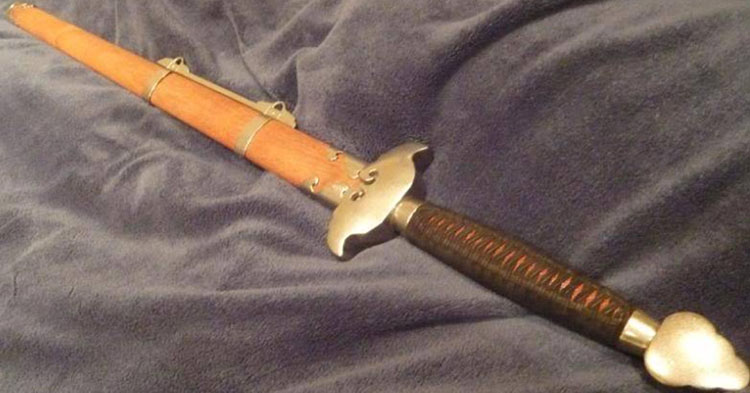

Statistics
- Blade/Jianti Length: 31 inches
- Handle/Jianba Length: 8.5 inches
- Overall Length: 39.5 inches
- Guard/Hushou Width:
- POB (Point of Balance): about 4.5 inches (33% of sword from pommel)
- COP (Center of Percussion): about 4-5 inches from tip
- Weight: 2lb 2oz (given specs)
The Blade/Jianti



Very well done. It does have the traditional “clamshell” or “appleseed”
geometry. The steel does seem different from typical Hanwei offerings,
although I’m no metallurgist. I’ve heard that Hanwei is now using their
own smelted steel for the jian as per Paul Chen’s decision, so maybe
it’s that.
Fear not, Hanwei non-katana owners, it does come sharp. Sure saved me some trouble.
There’s
a fair amount of flex judging from when I was wiping off the packing
oil. (I’m not going to attempt a flex test. Sorry.) It’s not whippy at
all though, unlike wushu blades.
Just a note that this is pretty much on the far end of the jian length spectrum. At 31 inches, it’s pretty long and despite a good weight and taper, you still feel that length when wielded. That or I’m really out of shape.
The Handle/Jianba


Honestly, when I first saw pictures online, the leather looked rather
gaudy. Luckily, it looked better in person, at least to me. The wrap is
very tight. I couldn’t find any movement at all. It also provides a very
good grip, whereas bare wood as found on some jian gets a tad slippery
during use. According to Scott Rodell, the handle is not traditional
hardwood; instead, it is a resin in order to resist cracking. For those
looking for something historically accurate, this may be a downside.
However, for practicality’s sake, it’s fine for me.
It is notable, though, that it’s very long. As I learned it, a jian handle (ba) should be able to accommodate a hand and a half. On this jian, I can fit both hands comfortably and still have room. Then again, I have fairly small hands. Maybe someone with meathooks will find it the perfect size.
The Guard/Hushou
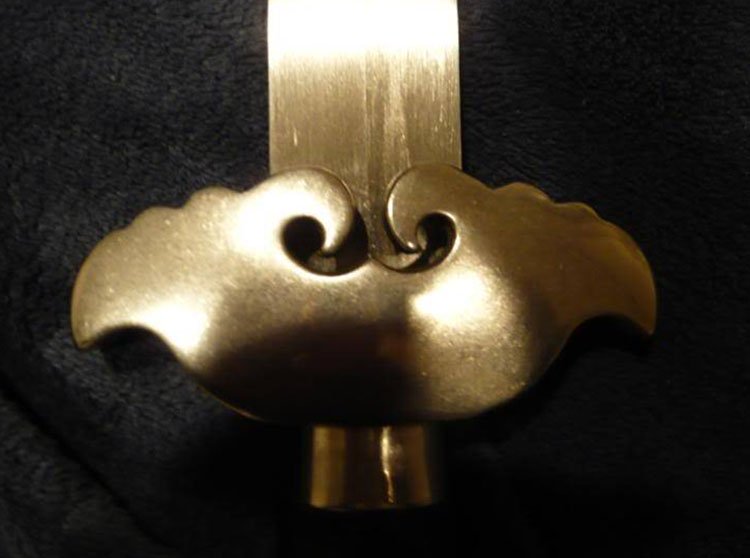

Not much to say. It follows the traditional later-period downward swept guards. Seems to be some sort of steel. Stainless, perhaps?
The Pommel/Jiantan

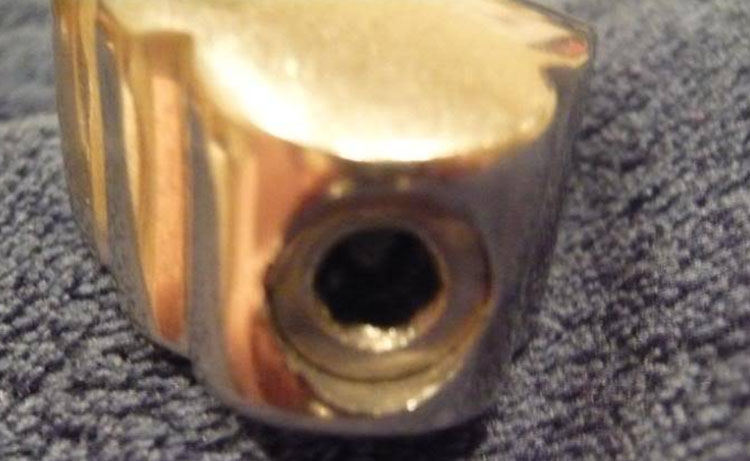
Steel, just like the guard. Recessed into the end is a hex nut for easy disassembly and maintenance.
The Scabbard/Jianqiao

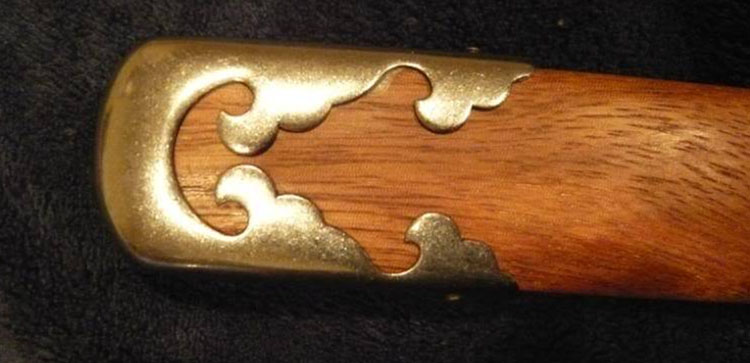

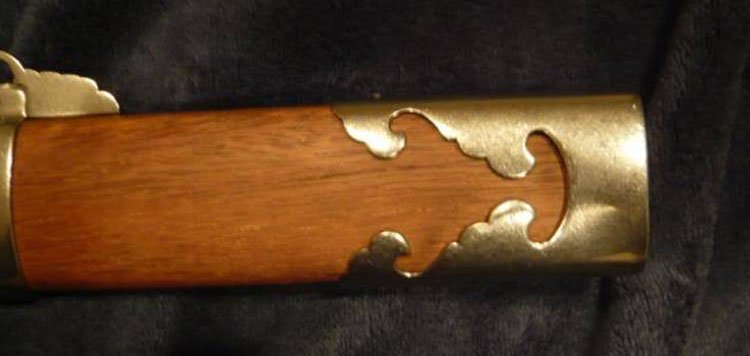
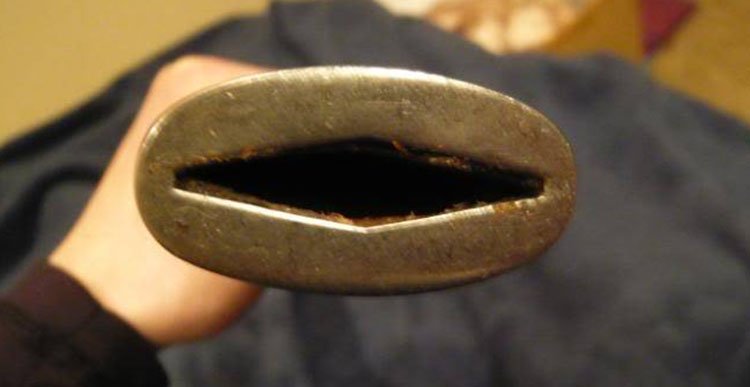
The scabbard is still possibly my favorite part of this sword. It fits perfectly, is made of beautiful rosewood while not being completely polished down for a rugged look, and has tight fittings. It’s a piece of art and a weapon in its own right, especially for the price.
Construction/Disassembly
It’s well known that Hanwei discourages cutting with its Chinese weapons line, and for good reason. The Rodell-designed cutting jian, however, fixes the construction problems that existed in the main line.
Let’s look at a comparison between the Damascus Tai Chi Jian and the Chinese Cutting Jian:
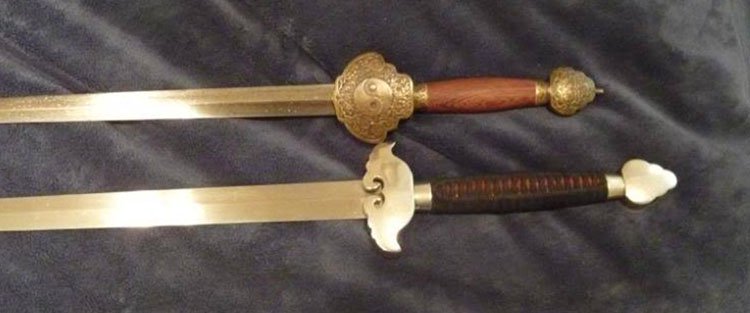 The Hanwei Damascus Jian (now discontinued) and the Cutting Jian
The Hanwei Damascus Jian (now discontinued) and the Cutting JianBefore disassembly, it’s already noticeable how much thinner the Damascus Tai Chi Jian’s blade is.
 Removing the pommel from the Damascus Jian
Removing the pommel from the Damascus JianPommel off and we already begin to see the problem with the old line. Believe it or not, that second nut on there is actually too large for the threading.

The grip isn’t horrible. It’s not hollowed out. However…

…the tang is just too thin to fit the grip. When the nuts aren’t secure, that grip can almost fully rotate.
Now here’s a look at the new construction:
 The components of the cutting Jian after disassembly
The components of the cutting Jian after disassemblyStill can be completely disassembled.
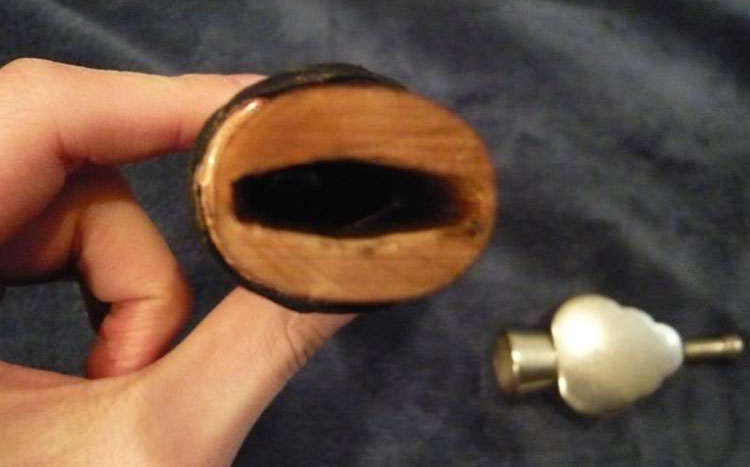
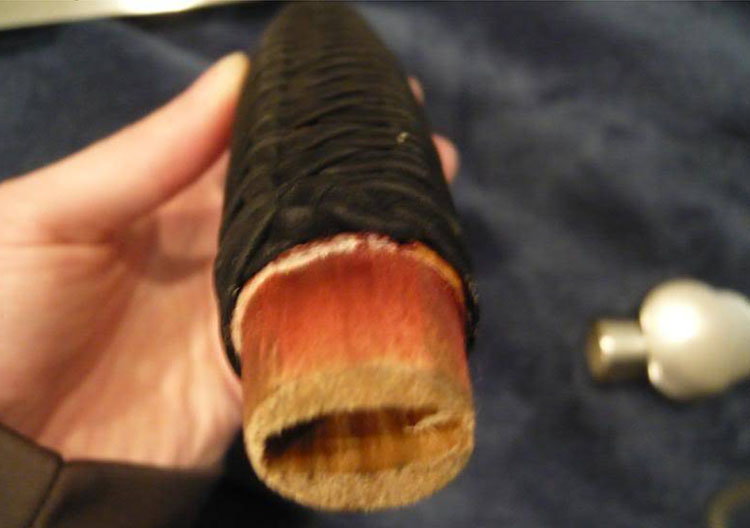
Seems to be one piece construction and is not hollowed out. It fits on the tang very snuggly. Despite being resin, I can’t tell. It imitates wood grain quite well.

Nice shoulders…

Great thickness throughout…and a non-welded threaded rod that’s just long enough for the hex nut.
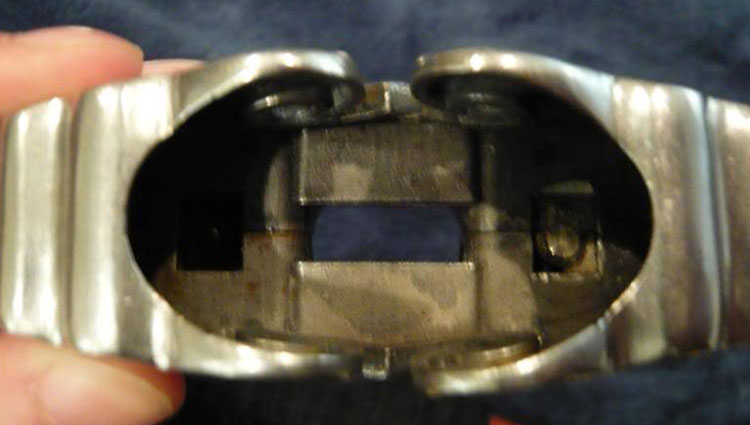
A quick look shows that the guard is hollow, which is true of many period pieces.
A huge improvement? Absolutely.
Handling Characteristics
With the way the POB and the nodes of balance are set up, the jian is
very maneuverable. Trying the “jiao jian” movement (that rotation around
the POB that you see in wushu movies) and just some dry handling, it’s
easy to get the sword to move as you desire.
However, with that length/weight, the feel is very different from lighter jian. Forearm strength/strong grip does help when wielding. Also, the POB does seem a bit close for its length. At 31”, it probably should be closer to 5-6 inches.
Test Cutting
When Scott Rodell did test cutting with the A&A Jian, he mentioned
that more force was required to cut with the traditional clamshell
geometry in comparison to modern repro jian made with diamond cross
sections. I didn’t particularly think so, although I found that edge
alignment had to be absolutely perfect for a clean cut. I’ll have to
spend more time with it when I’m not on lunch break and wearing a suit.
I admit that my form here stinks quite a bit. I was focused more on getting nice looking results. Probably could've cut through that last container too, except I kept trying to compensate for the extra inches on the blade. This resulted in shallow cuts a couple times.
Conclusion
Is it my dream jian? No. I’d prefer a shorter handle and an inch or two off the blade. Is it good though? Oh yes. The blade geometry is accurate, the fittings are still tight after use (and some abuse, I admit), and the scabbard and blade make it worth more than the 300-ish price level. When the Rodell-designed dao comes out, I may have to pick one up as well.
For
the CMA practitioner or jian enthusiast, there aren’t that many options
for a jian when you’re on a budget. The $300-level production jian market is pretty much left to
Kris Cutlery, Cold Steel, and Hanwei. Would I recommend this over the
others? Absolutely. It’s a jian designed for practitioners by a noted
practitioner/teacher/collector, and it definitely delivers.
PROS
- Traditional clamshell blade geometry
- Comes sharp
- Beautiful rosewood scabbard for the price
- Designed by Scott Rodell
CONS
- Long jian(both blade and handle) may not be what some CMA enthusiasts prefer
- Hex nut/resin handle are not traditional
- Leather wrap on rayskin is a hit or miss look.
WHERE TO BUY
Sadly the cutting Jian ceased production in late 2024 and is no longer available to purchase. It is unclear at this time if or when it will return to production - so when something changes, we will update the review accordingly.
I hope this review of the Hanwei Scott Rodell Cutting Jian has been helpful. To return to Chinese Swords from Hanwei Cutting Jian Review, click here

Buying Swords Online Can Be DANGEROUS!
Find the Best Swords in the:
Popular & Recommended ARTICLES

The ONLY true free online magazine for sword enthusiasts. Delivered once a month on the 1st day of the month, no filler and no BS, just the latest sword news & info delivered straight to your inbox.












